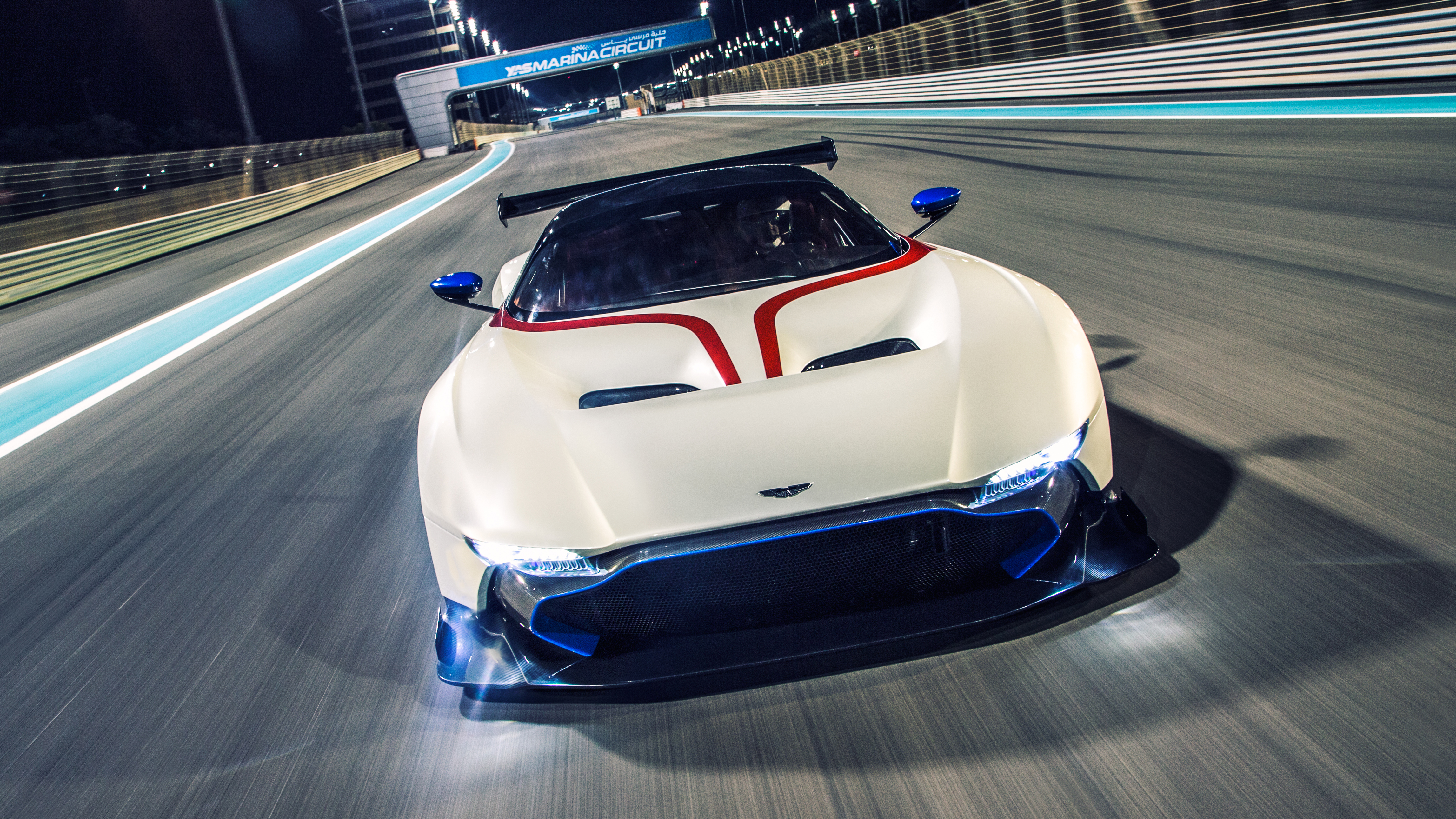
World exclusive first drive: Aston Martin Vulcan
What is it?
It’s the Aston Martin Vulcan, Aston’s track-only, One-77-based answer to the McLaren P1 GTR and Ferrari FXXK. It’s got 820bhp and, above 190mph, delivers more kilos of downforce than it weighs.
Wait, doesn’t that mean…?
Yep, it’s the old F1 chestnut – find somewhere to drive upside down and the 1350kg Vulcan will glue itself to the ceiling.
And you’ve driven it?
Yep. Wasn’t a bad day out as these things go. Got to play on the Abu Dhabi GP circuit and all.
Sorry, being an idiot. Aston is only building 24 of these and for two days one of the £1.8 million machines was ours. It was a massive, massive privilege and one hell of an experience. Downshifts shock the car, flames flash and lick about, the side pipes pop, rumble and crash, shift lights flash, gears whine, the V12 soars and shrieks – it’s a mashing, roaring mechanical melee. So yeah, just a bit special.
And it’s based on a One-77?
Sort of. The back story runs something like this: Fraser Dunn, chief engineer of Aston’s Q Advanced Engineering division, and David King, Director of Advanced Operations and Motorsport, got chatting about some old One-77 development prototypes that were kicking around. Unsurprisingly their first thought was to make a faster one. They envisioned a One-77 R.
The trouble was that the project that interested and excited them also bought out the small boys in almost every other department at Aston Martin. Design wanted a piece of the pie, and when they got the go ahead to make some sweeping changes, including shaping the bodywork in carbon instead of aluminium, every other department started pushing to make equally significant changes.
Top Gear
Newsletter
Thank you for subscribing to our newsletter. Look out for your regular round-up of news, reviews and offers in your inbox.
Get all the latest news, reviews and exclusives, direct to your inbox.
So the plan to use the existing 7.3-litre V12 was abandoned. Aston Martin Racing pointed out that they had a very potent 6.0-litre V12 running in the Vantage GT3 racer, that, with a significant amount of modification (including gaining a litre of capacity), would deliver on one of the key parameters – over 800bhp.
What about the aero, too?
OK, here’s one for you – guess which single element on the car delivers the most downforce?
Easy, gotta be that rear wing. You could taxi a Boeing on that.
Nope, it’s the underbody diffuser. Look at the size of the front splitter and imagine how much air it channels under the car. And because it’s front-engined rather than mid-engined, once that air is slicing along underneath, the diffuser can be opened out earlier, generating more suck further forwards.
But it’s not just the big aero components. Those vents aft of the front wings extract high pressure air that builds up in the front wheelarches. The race-minded engineers wanted them to expel upwards through the bonnet, but Marek Reichman, Aston’s design chief, wouldn’t permit that – he wanted the big expanse of bonnet – so they vent onto the flanks. The aero compromise turned out to have an unanticipated benefit: the tumbling, extracted low pressure air draws higher pressure air from the bonnet down on to the sides of the car, improving the flow.
OK, but it’s not that powerful alongside the McLaren and Ferrari, is it?
In terms of pure numbers, no. It delivers 820bhp at 7750rpm and 575lb ft of torque at 6500rpm, while a P1 GTR has 986bhp and 737lb ft. Both weigh within a few kilos of each other, but here’s the thing about power figures: they’re disruptive. They condense everything about a car’s performance into a solitary, web digestable, easily repeatable number. But it’s what that horsepower feels like, that’s the ticket, and in the naturally aspirated V12 Aston it feels pretty bloody special.
The feeling of energy at idle is colossal, the whole car trembles, and if you blip the revs, they scream to the limiter and back in an instant – vap, vap, vap – proper motorsport stuff. It feels properly hardcore – massive seats inside, F1-style steering wheel, juddery clutch when pulling away, gear whine, squeaky brakes and all the rest.
Once you’ve got temperature into the engine and tyres, though...
It runs slicks doesn’t it?
It does, although Aston equips it with Michelin Pilot Sport Cup 2 tyres initially – just to get you used to the car. It also has three power modes: 550bhp, 675bhp and then the full whack of 820bhp.
You don’t care about 550bhp mode, nor 675. All you need to know is that each time I flick the dial onwards, the Vulcan kicks forwards. One fifty on the back straight at Abu Dhabi becomes one-six-five, becomes one-seven-five plus. At the 200 metre board I hit the brakes with everything I have. Everything. You can do this when the car currently weighs about 2.5 tons and is wearing 305-width front slicks. The carbon Brembos have massive power and mashing the brakes, knowing you’ll never lock them, trying to release the pressure gradually as the aero grip bleeds away and the car lightens, carrying braking all the way to the apex to keep the nose locked on line – it’s an addictive business.
You have to give yourself over to it, like a self-inflicted fairground ride. I find myself whooping and hollering into my helmet, at once carefree and focused, both loving the wild ride and intent on getting the throttle application dead-on. Because then it’s V12 time.
Naturally aspirated, ultra-responsive, wondrous, strident and sonically magnificent. It howls. Shrieks almost. Like an old V10 era F1 car, but slightly less shrill. The sound pulses pile on top of each other, the detonations more densely packed than in a V8, coming faster and harder and more urgently, each forcing speed from the car.
It’s fast alright, but on a circuit you never really notice just how fast because you’re locked into the seat so tightly and have other things to preoccupy you. I do feel the drag start to press on the car above 150mph, restricting acceleration, and overall the balance between grip and power is probably fractionally in favour of grip, but the way the car drives, the sensations it delivers, are just… remarkable.
Why’s that?
No road car drives like a racing car. And true, this isn’t a genuine racing car (although by featuring an approved roll cage it can be eligible for some racing, including the VLN series, if some slight mods were made), but it’s close and the downforce and grip demand a very different driving style.
And of course you can make changes to it as your ability develops and improves. As I build a better picture of it, I decide I’d quite like more direct steering just off centre, the brakes to have even better bite right at the top of the travel, the gearing to be shorter so I could counter the downforce above 150mph with more high rev shove in fifth and sixth, the damping to recover its composure more quickly after the nasty bumps just before the braking zone on the back straight. Maybe a little less roll to sharpen up the direction changes in the chicanes.
All this is possible. You can change the dampers, toe angles, caster, cambers, gear ratios, fuelling, tyres, whatever. Just come in, have a word with your engineer, maybe go over your data traces. It’s the bloody ultimate track day car and you’ve paid enough for it, so play around with it, indulge yourself. Why the hell not? That’s what it’s there for. It can change and develop with your talents and experience.
But as it is, it’s OK?
Way more than that. There’s a sense of real calmness under pressure that rubs off on the driver. All movements are smooth and well telegraphed. It doesn’t snap or twitch, but moves progressively, calmly, gives you pointers and nudges to make you aware. As it is it’s deliciously neutral, small throttle adjustments, particularly at high speed, having marked effects on your trajectory and line.
Out at turn 14 I left my braking too late and backed the damn thing into the corner. Anything mid-engined with steering lock this minimal would have pivoted on the spot, but the Aston just nudged out a couple of degrees as a warning, and I got to keep my dignity and feel like a hero for whapping into, through and out of the crucial marina corner while carrying a breathless gasp of oppo.
The balance between aggression and suppleness is spot-on. When I push the Vulcan about a bit, I discover that it will understeer mildly wide of the apex if you’re too greedy too early with the throttle, it’ll also oversteer if you attempt to nullify that with extra throttle. Too much brake and the back will step out when you put some steering on. The lateral grip, even at three figure speeds, will eventually run out, pushing the front off line. But as I said earlier, all this is solvable, changeable. There’s a proviso, though...
Which is…?
You have to drive it properly. If you leave your downchanges later, they’ll kick through the drivetrain, jolting the car. The brakes squeal madly, tauntingly, if they’re not used hard enough. The traction control isn’t that sophisticated. Try as you might to hold the throttle steady as you process down the pitlane, it’ll kangaroo and lurch. It feels truculent until you get up to its pace. After that, though, it’s just staggering.
Is it tiring to drive?
Exhausting. Five laps and I’m spent – I start to get a headache, I need to drink, sweat gathers, ears ring. I haven’t heard a word from my engineer on the pitwall, because even with the intercom turned right up, he’s fighting an unwinnable battle against the V12. When someone else goes out you can hear them around the whole circuit, each gearshift, each lift. When they howl down the pit straight, shockwaves battering the grandstands, it’s actually painful. Moments later, you can taste the pungent fumes.
And it flames?
Does it ever! OK, so Aston put it on a ‘special’ engine map to help things along, which meant that every time I lifted off, I could hear a wumph from the exhausts just outside the door – and if I was alongside a wall, I’d see the orange glow reflected back. Just nuts. Made the photo and video boys very happy indeed.
And when the side pipes aren’t gobbing fire out, each exhaust is an entrance to Hades, glowing orange in its depths. Couldn’t believe that when I first saw it.
What about the way it looks?
Like most racing cars, it’s better from the back than the front – there’s just more going on. The low rear three quarter angle where the view is mostly wing, the carbon bazooka that passes for a side exit exhaust, and those lollypop stick rear lights, is sensational.
I’m less sure about the front. Get the angle right – relatively low, so you can actually see it has headlights tucked under the bonnet lip – and it’s great, but if you come high all you see is a bubble cockpit and this massive expense of bonnet and it looks a bit plain.
Anything surprising about it?
The quality of the fit and finish. I don’t know why that should surprise me quite so much, but the door closure is precise, the bonnet rises on gas struts, the precise feel and click of the paddles, the power of the aircon blower, the leather, toggle switches… the design and execution is stunning.
And it’s logical to operate – the steering wheel is a work of art, both visually and ergonomically.
And you got to drive it at night.
I know. That was just so cool. Abu Dhabi has no noise restrictions and runs until midnight. I’ve had some ridiculously good moments in my job, but I can genuinely say that each lap in the Vulcan was a privilege, particularly the fast third gear double apex right hander as you plunge down to the glowing purple Yas Viceroy hotel, whapping down two gears, flames spouting, making sure you punish every apex and kerbstone in front of the spectators. Every lap feels naughty. Illicit. Mischievious. Great. Can’t say fairer than that really. Pure magic.
Photography: Richard Pardon
Featured

Trending this week
- Car Review
BMW 1 Series
- Top Gear's Top 9
Nine dreadful bits of 'homeware' made by carmakers









